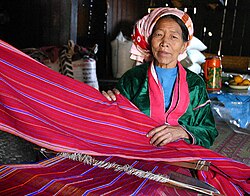Palaung people
 A Ta'ang tribal woman near Kalaw, Shan State, Burma. | |
| Total population | |
|---|---|
| 557,000 (est.) | |
| Regions with significant populations | |
| Burma, smaller populations in China: Yunnan, Thailand | |
| Languages | |
| Ta'ang | |
| Religion | |
| Theravada Buddhism |

The Palaung (Burmese: ပလောင် လူမျိုး [pəlàʊɴ lùmjó]; Thai: ปะหล่อง, also written as Benglong Palong) or Ta'ang are a Mon–Khmer ethnic minority found in Shan State of Burma, Yunnan Province of China and Northern Thailand. In China, they are referred to as the De'ang (Chinese: 德昂族; pinyin: Déáng Zú also spelt Deang) people.
They live mainly in the northern parts of Shan State in the Pa Laung Self-Administered Zone, with the capital at Namhsan.
The Ta'ang (Palaung) State Liberation Army, the armed wing of the Palaung ethnic group, began fighting against the Burmese military in 1963. It entered a cease-fire agreement with the central government in April 1991, but is currently continuing the insurgency.[1] Both the government and the rebel armies have derived benefit from poppy cultivation, which has caused serious drug addiction among the local people.[2]
Groups
There are three main subgroups of Ta'ang: the Palé, Shwe and Rumai.[3]
The Chinese government groups together the Palé, Riang, Rumai and Shwe peoples as the De'ang ethnic nationality. The group also includes the Danau (Danaw) who may no longer have a separate identity from the Palé.
Language
There are three principal Palaung languages.
Distribution
In China, the De'ang are found in the following villages of Zhenkang County and Gengma County.[4] In China, they are known as the Laopulao 牢普劳; there are 6 other De'ang groups located in Burma.[4]
- Dazhai Township 大寨乡, Muchang District 木厂区, Zhenkang County: Bangwa 邦娃 (Dazhai 大寨), Xiazhai 下寨, Huoshishan 火石山, Laobandeng 老班登, Mahuangqing 蚂蟥箐 of Chaikao 柴考
- Nansan Township 南伞乡, Pengmushan District 彭木山区, Zhenkang County: Xiaochanggou 销长沟, Beiyan 北岩
- Hongmulin 红木林 and Manxing 曼兴 of Hewai District 河外区, Gengma County: Junnong 君弄, Mamao 马冒, Jinmo 金莫, Muyin 木因, Xungang 巡岗
Religion
Most Ta'ang are adherents of Theravada Buddhism and Buddhist temples can be found in most of their towns. Buddhism is present in all of the daily activities of this ethnic group. At the age of 10, many children are sent to the monasteries, primarily for education. Most of them return to lay life in later years.
The Riang are the only one of the four groups who have never converted to Buddhism. The majority of the Riang are animists.
See also
Further reading
- Palaung Women's Organisation. (2006). Poisoned flowers: the impacts of spiralling drug addiction on Palaung women in Burma. Tak, Maesot, Thailand: Palaung Women's Organisation.
- Ashley, S. (2006). Exorcising with Buddha palaung Buddhism in northern Thailand. Ottawa: Library and Archives Canada = Bibliothèque et Archives Canada. ISBN 0-494-03309-6
- Howard, M. C., & Wattana Wattanapun. (2001). The Palaung in northern Thailand. Chiang Mai, Thailand: Silkworm Books. ISBN 974-88325-1-1
- Cameron, A. A. (1912). Notes on the Palaung of the Kodaung Hill tracts of Mong Mit State. Rangoon: Govt. Printer.
- Milne, Mrs. Leslie. The Home of an Eastern Clan: A Study of the Palaungs of the Shan State, Oxford, Clarendon Press (1924).
Gallery
References
- ^ Ta’ang army suspends talks with govt as clashes continue
- ^ Turning a new leaf? Ethnic rebels along Myanmar's rugged frontier help eradicate poppy fields
- ^ Ta'ang = The Peoples of the World Foundation
- ^ a b 中国少数民族社会历史调查资料丛刊》修订编辑委员会. 2009. 德昂族社会历史调查, p.94. Beijing: Minzu Chubanshe.
External links
 Media related to De'ang people at Wikimedia Commons
Media related to De'ang people at Wikimedia Commons- Ta'ang Students and Youth Organization





